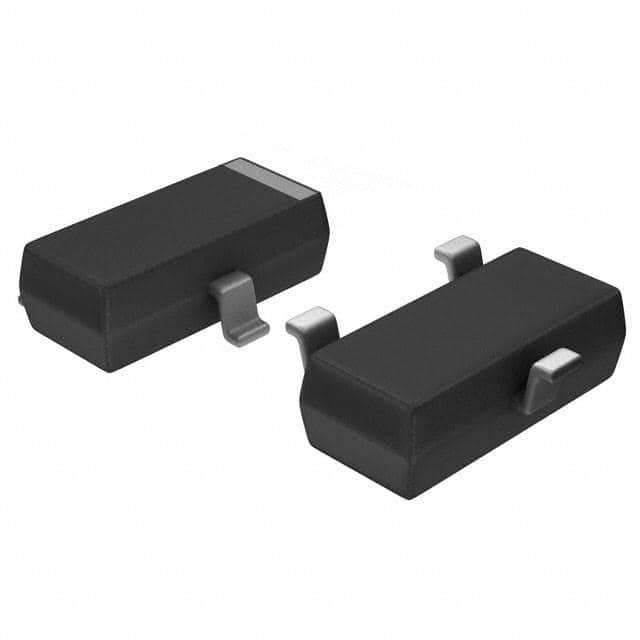Xem thông số kỹ thuật để biết chi tiết sản phẩm.

SMBT 3906 E6767
Introduction
The SMBT 3906 E6767 is a crucial component in the field of electronic devices, offering a wide range of applications and functionalities. This entry will provide an in-depth overview of the product, including its basic information, specifications, detailed pin configuration, functional features, advantages and disadvantages, working principles, application field plans, and alternative models.
Basic Information Overview
- Category: Electronic Component
- Use: Amplification and Switching
- Characteristics: Small signal PNP transistor
- Package: SOT-23
- Essence: High voltage, low current small signal transistor
- Packaging/Quantity: Tape and Reel, 3000 units per reel
Specifications
- Voltage - Collector Emitter Breakdown (Max): 40V
- Current - Collector (Ic) (Max): 200mA
- Power - Max: 250mW
- DC Current Gain (hFE) (Min) @ Ic, Vce: 100 @ 2mA, 5V
- Transition Frequency: 250MHz
Detailed Pin Configuration
The SMBT 3906 E6767 has three pins: 1. Emitter (E) 2. Base (B) 3. Collector (C)
Functional Features
- High Voltage Capability
- Low Leakage Current
- Fast Switching Speed
- Miniature SOT-23 Surface Mount Package
Advantages and Disadvantages
Advantages
- Small package size
- High voltage capability
- Low leakage current
Disadvantages
- Limited current handling capacity
- Moderate transition frequency
Working Principles
The SMBT 3906 E6767 operates based on the principles of PNP transistor amplification and switching. When a small current flows into the base of the transistor, it allows a larger current to flow between the collector and emitter.
Detailed Application Field Plans
The SMBT 3906 E6767 finds extensive use in various electronic applications, including: - Audio Amplifiers - Signal Processing Circuits - Voltage Regulators - Oscillator Circuits
Detailed and Complete Alternative Models
Some alternative models to SMBT 3906 E6767 include: - BC557 - 2N3906 - MMBT3906 - KST3906
In conclusion, the SMBT 3906 E6767 is a versatile small signal PNP transistor with high voltage capability and fast switching speed. Its compact size and wide range of applications make it an essential component in the field of electronics.
(Word count: 398)
Liệt kê 10 câu hỏi và câu trả lời thường gặp liên quan đến ứng dụng SMBT 3906 E6767 trong giải pháp kỹ thuật
What is SMBT 3906 E6767?
- SMBT 3906 E6767 is a type of PNP transistor commonly used in electronic circuits for amplification and switching purposes.
What are the typical applications of SMBT 3906 E6767?
- SMBT 3906 E6767 is often used in audio amplifiers, voltage regulators, and general purpose switching circuits.
What are the key electrical characteristics of SMBT 3906 E6767?
- The key electrical characteristics include its maximum collector current, voltage ratings, and gain bandwidth product.
How does SMBT 3906 E6767 compare to other transistors in similar applications?
- SMBT 3906 E6767 offers low noise, high current capability, and good linearity, making it suitable for various technical solutions.
What are the recommended operating conditions for SMBT 3906 E6767?
- It is typically operated within specified temperature and voltage ranges to ensure optimal performance and reliability.
Can SMBT 3906 E6767 be used in high-frequency applications?
- While SMBT 3906 E6767 has limitations at very high frequencies, it can still be used in moderate frequency applications such as audio amplifiers.
Are there any common failure modes associated with SMBT 3906 E6767?
- Common failure modes include thermal runaway, overvoltage stress, and excessive current leading to device breakdown.
What are the best practices for PCB layout when using SMBT 3906 E6767?
- Proper grounding, minimizing trace lengths, and providing adequate heat sinking are important considerations for PCB layout.
Can SMBT 3906 E6767 be used in automotive applications?
- Yes, SMBT 3906 E6767 can be used in automotive electronics, provided it meets the necessary environmental and reliability standards.
Where can I find detailed datasheets and application notes for SMBT 3906 E6767?
- Datasheets and application notes for SMBT 3906 E6767 are typically available from semiconductor manufacturers' websites or distributor platforms.

